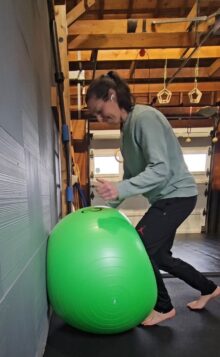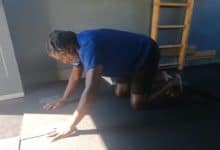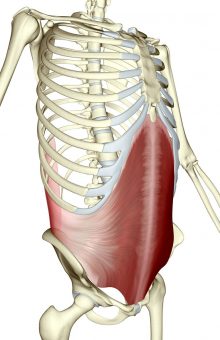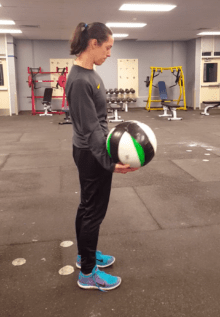Alternative Title: Describing the Avoidant Half I have been writing about asymmetries for some time. Whether it be determining the up leg from from down leg, or the pitfalls of detorsioning the system, I continue to find and… Read more ›
Asymmetry. Up Leg. Compression. Push Down. Space. Rotational Organization. These all describe the physics of one half of the body accepting load, and one half of the body avoiding load. The first time I wrote about this, I referred to… Read more ›
In my athlete days, which ended about 15 years ago, the goal was to NOT feel and just complete the tasks put to paper. It was something I was given or sought out — “more” was agreed upon by all… Read more ›
The first post in this series asked if a pigeon toe was friend or foe. It is certainly a strategy, an adaptation that has a purpose. For me, my half with the pigeon toe also carried my biggest problems, particularly… Read more ›
Oh, the mighty pigeon toe. Such a strange little insurgent, and yet, it exists peacefully all around us. Where does it come from and how does it form? Does it afflict one leg or both? Is it the tibia or… Read more ›
Part 1 of this series explained how knee should not be used as a load-bearing joint. Part 2 showed how pressuring the knee can help build safety, alignment, and desired force at the desired time. This third and final segment… Read more ›
In part 1, I suggested that using the knee as gas instead of brakes could help free up the knee for motion and elicit the hips and ankle-foot as stabilizers. For folks with chronic pain, however, their nervous system likely… Read more ›
Torsion. We all have it: a particular line of twist running through our carriage, gripping us in a certain way and keeping us upright. Each fold and joint tells its story, whether you realize it or not. It’s how we… Read more ›
My previous post got into the shame and embarrassment that prevents many of us from addressing issues with parts connected to sex or excrement. This one is more objective, looking at anatomy and physics. When you seek to understand the… Read more ›
To recap Part One: Create a sense of intrigue Provide multiple points of entry Establish pockets of safety Ask instead of assume This sh*t’s hard (which is why so few do it) After the weight shift lesson , three of… Read more ›
When new words are introduced, we tend to react as if they make things more complicated. We already know. We already have an understanding on what the terms we already use mean. Why would we change? We change when we are… Read more ›
Pairs. Roles. Asymmetry. The body knows and the body has ways. Understanding the differences between the halves helps you appreciate them. One side isn’t ‘good’. The other isn’t ‘bad’. They hold a function within the system. Here’s a big picture… Read more ›
Flexion and extension. Compression and Suspension. There are pairs that govern movement, both globally and locally. The system and its parts act to pull apart and come together. Posture, moving fast, and any sort of training or exercise is versed… Read more ›
This piece serves as the follow up to How To Push Down. When we are talking about compression, we are also talking about tension. It is the interaction of these two push-pulls that creates suspension. Otherwise everything would collapse. … Read more ›
This post serves as a follow up to: A Path Towards Harm. Otherwise titled: The things I did wrong when I didn’t pay attention or have compassionate patience. The tag to this blog used to read, “fix yourself.” But… Read more ›
This post serves as a companion piece to A Non-Central Axis. Where it showed you ways to identify a shifted midline, the following hopes to show how pulling to the right or left affects performance. The first thing to… Read more ›
The two bowls of the torso work in relation to one another. The ribs act as an upside down bucket and psoas sticks. The pelvis acts as as a rotary basin with hip handles. Should they be able to freely… Read more ›
A quick conceptual piece from the mind of Nicole Uno. Like many sensational metaphors she offers me, I cannot quite make sense of things until I feel it’s application and usefulness. Instead of trying to force the issue, I typically… Read more ›
This hurts. The most common reaction is to stop using it or doing that. It’s even the advice of many medical professionals. Rest, it is assumed, is a cure all. But what happens when this magic pill doesn’t work? When… Read more ›
As I am learning to access and mobilize my ribs, I have begun to understand and control the deep inner workings of my trunk, particularly the space between the ribs and pelvis. One might think of this as the shortest… Read more ›
The following is part two of my course notes and findings from Stress, Movement, and Pain. As practitioners seeking to help bio-psycho-social organisms, we have to be able to read, analyze, and gather information from all three dimensions. The… Read more ›
The following is a glimpse into the mind of Nicole Uno (IG @unotraining). Rotational Organization allows for the simultaneous existence between contract and relax. Thoroughly simplified, consider two gears. There is an impetus of force and a corresponding area… Read more ›
For a long time, I believed that extension was the working opposite of flexion. They felt as contrary as they looked. Folding forward was natural and effortless. Folding back was a resistance to that ease. The struggle was a lesson… Read more ›
Two years ago, I set to develop a “new” type of PE that looked outside the realms of sport and weight lifting. With the outliers as my muse, we set to examine movement with a larger lens — how one… Read more ›
Matan Levkowich is a dancer, choreographer, and martial artist. Another of the incredible Israeli movers, he is able to pluck out threads from all the worlds he has immersed himself in and deliver them in practical form. He first blipped… Read more ›
If you’re curious about why only half a workshop I’ll tell that story at the end. Tom Weksler’s Movement Archery workshop was a lesson in angular momentum. We rolled, we spun, we bruised our pointy bits. Imagine an archer… Read more ›
Movement expression is dependent on on our tadpole-like head and spine to drive and disperse motion. Any sticking points have a reverberatory effect on the actions of the limbs. After a decade of undoing the rigidity trained through athletics and… Read more ›
When I got my first chin up, I felt superhuman. Finally hitting that relative strength benchmark felt like a magic trick I was somehow involved in. Even more mystifying, though, is that I had absolutely nothing on a pronated grip… Read more ›
The low gait might be the truest test of healthy knees. It requires full flexion under full bodyweight while pulling the center of mass. A single knee is responsible for stabilizing load while the feet and ankles pivot and reposition.… Read more ›
Engaging with your work demands a certain degree of ownership. There must be a benefit to the challenge presented, beyond just a hard-to-apply confidence. A task can serve as a test of will, a test of adaptability, and/or a test… Read more ›
Doing without knowing. Playing, creating, learning. Adjusting and adapting. Describing Fighting Monkey is an act in organizing verbs. Everything overlaps and intertwines and is a wonder. The only certainty you are left with is that you have experienced something good… Read more ›
Issues with joints or body parts can almost always be traced back to usage. When faced with a familiar task in a familiar environment, our habitual patterns of movement follow a particular chain of command. We clutch and are clutched… Read more ›
“I’m going to explore the depths of the ocean.” “You’re gonna what?” “I’m going to get into this magical pressure suit, close myself off to the known world, and look for cool stuff.” “Why would you want to do… Read more ›
Movement overlaps. Brain work = joint work = speed, power, strength, and coordination work. We have structures and we have capacities. Our practice establishes the abilities of both. There is a general consensus that if your parts work better you’ll… Read more ›
Body control is all the rage. A popular want is increasing active range of motion. People want to get there so they can do stuff there. Functional Range Conditioning uses slow, controlled movement to examine individual joints, build capacity in… Read more ›
Hip extension is a vital movement to both health and performance. Wellness wise, hips that can extend, coupled with an unstuck spine and pelvis that can naturally posteriorly tilt, means you likely don’t suffer from back pain. Power and speed… Read more ›
Increasing dorsiflexion is a popular yet frustrating goal. Getting the ankles to do more lessens the strain on the knees, and is an important factor in being able to drop into a deep squat — an often used marker of overall… Read more ›
The vast majority of movements happen going forward. We reach, walk, look, and move toward what’s in front of us. Then we sit by pushing our butt backward. This front-to-back plane of motion (or stillness) is where we reside. Our… Read more ›
The pelvis speaks volumes. The position in which you hold it dictates whether or not you can use your abs, release your hip flexors, and/or likely have symptoms of back pain. It’s the first thing I check with new clients… Read more ›
We tend to move in ingrained patterns, within the same degrees and utilizing the same amount of space. Thinking bigger about what a joint is capable of doing allows us to use it in ways we don’t, which often aligns… Read more ›
Sliding is one of the most fun ways to get from here to there. True to form, it’s also a sneaky little way to grasp an underlying understanding of movement. F=ma (force equals mass times acceleration) is explained in… Read more ›
The tip toes position is an assessment of toes, feet, and ankle control. Balance comes from joint stacking. The push off when we walk comes from a high heel. A toe point or push is required with reaching. Loaded plantar… Read more ›
Thirteen years ago, I had ACL reconstruction surgery using a hamstring graft. My tissues have long since ‘healed’, but the overall function still lacks behind my non-injured leg. Full flexion remains it’s biggest weakness. Here’s snapshot of the discrepancy in… Read more ›
For any of you who have followed this blog for a while, the pelvis has been a long-standing fixation of mine. It has routinely been the deciding factor in moving better and getting out of pain (particularly low back pain). Boldy put, if… Read more ›
featured photo credit: @movnat instagram (Carlos Condit) The ground is a safe, secure place. It is not something to be avoided or stepped lightly onto. It can easily absorb our falls and placements and pressures. If we become afraid… Read more ›
As examined in my previous post, joint function defines what kind of movements you are prepared to perform. Articular independence must come before articular interdependence. The ability to isolate a particular joint leads to more control, increased awareness, and lessening… Read more ›
Yesterday, Guido Van Ryssegem was gracious enough to speak to us at the Free Salem Fitness Summit. While his topic was “Resolving Upper Extremity Movement Dysfunctions”, he delivered plenty of nuggets regarding motor learning in general. Here are three gems I… Read more ›
I was fortunate enough a few weeks back to watch a presentation put on by Jim Ratcliffe. Obsessed with speed and acceleration, he has made Oregon athletes some of the fastest and most successful around. Quite possibly the most energetic… Read more ›



















































